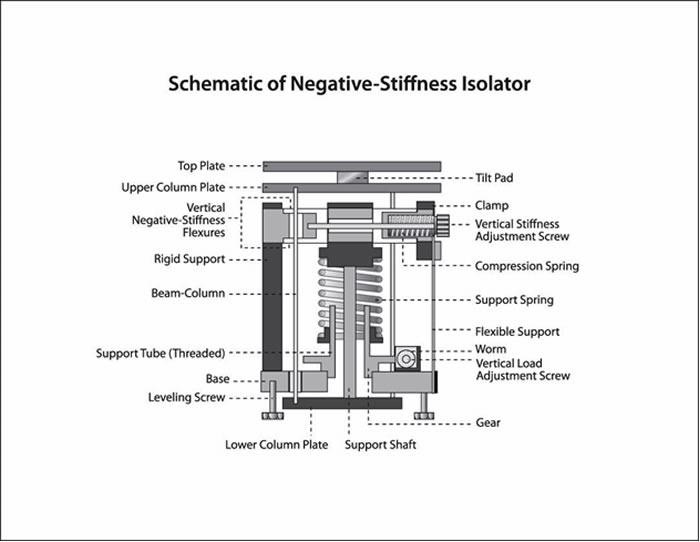Pacific Biosciences has produced its next generation of long-read, automated genomic sequencers with Single-Molecule, Real-Time (SMRT*) sequencing technology. The Sequel™ system is part of the company’s continued work in revolutionizing discovery-based research to understand the most complex systems in biology.

The Pac Bio Sequel II utilizing Minus K Negative Stiffness Vibration Isolation from Pacific Biosciences
The sequel system is very multifaceted in operation. It encompasses robotics, chemical and biological processing and photonics.
Kevin Lin, Mechanical Engineer, Pacific Biosciences
Excessive ambient vibrations were identified as a risk to the data because the system was designed to be used in a range of R&D settings.
Lin explained, "We needed to implement a vibration isolation component that would not only isolate the sensitive components from vibrations, but also that would be sufficiently small, compact and integrative.”
Vibration can be produced by a range of factors, both external and internal, to the building in which the system is located.
These vibrations can originate from ventilation and heating systems, pumps, fans, adjacent road traffic, elevators, overhead aircraft, nearby construction, and even weather and windy conditions. Vibrations as small as 2 Hz can be produced by these influences, which leads to significant disturbances in sensitive systems.
A vibration isolator was required by Pacific Biosciences that would be small enough to fit into its Sequel system, which is significantly smaller than its prior sequencer by around 60 percent.
Negative-Stiffness Vibration Isolation

During the design of the Sequel system, we did considerable research into various vibration isolation option including active isolation systems and smaller modified air tables. The option we decided on was the performance that negative-stiffness isolation provides.
Kevin Lin, Mechanical Engineer, Pacific Biosciences
Negative-stiffness isolators, created by Minus K Technology, use a distinctive, fully mechanical concept in low-frequency vibration isolation. They do not require compressed air or electricity.
As there is nothing to wear out, there are no pumps, chambers, motors, and no maintenance required. They function entirely in a passive mechanical mode.
Negative-stiffness vibration isolation systems allow vibration-sensitive instruments, like the Sequel system, to function in very low-vibration environments due to their high vibration isolation efficiencies, especially at low frequencies. With top-performance air tables and other vibration-mitigation technologies, this cannot be achieved.
Dr. David Platus, president and founder of Minus K and the inventor of negative-stiffness isolators, explained, "In negative-stiffness vibration isolation, vertical-motion isolation is provided by a stiff spring that supports a weight load, combined with a negative-stiffness mechanism.”
"The net vertical stiffness is made very low without affecting the static load-supporting capability of the spring. Beam-columns connected in series with the vertical-motion isolator provide horizontal-motion isolation.”
“A beam-column behaves as a spring combined with a negative-stiffness mechanism. The result is a compact passive isolator capable of very low vertical and horizontal natural frequencies and very high internal structural frequencies."
Platus worked in the defense, nuclear, and aerospace industries before founding Minus K, where he managed and oversaw design and analysis projects in structural-mechanical systems. More than 20 patents connected to vibration and shock isolation are owned by Platus.

The main consideration for selecting negative-stiffness was eliminating hysteresis in the isolator, a key component in the system’s operation. The isolator is secured to the Sequel instrument’s mainframe and interacts physically with the internal robot, leading the isolator to move slightly after every interaction.
The repeatability and efficiency at which the vibration isolator can return back and cancel out this movement are crucial to the system’s function. The negative-stiffness isolator performs more effectively than the pneumatic isolators in this respect.
Pacific Biosciences of California constructs sequencing systems to enable scientists to find solutions to genetically complex issues. The techniques employed by scientists have been revolutionized by PacBio with its extensive history of collaboration and a focus on engineering high-value and high-quality technology.
The organization’s sequencing systems, from consumables to software, are based on its SMRT technology and offer an efficient, simple, end-to-end workflow for SMRT sequencing.
We were attracted to negative-stiffness because of the high vibration cancellation performance of the isolator and its favorable hysteresis. We were also attracted to its simplicity of operation. Nothing is needed to supply and control air and there is no need for electrical connections. It is also lightweight and compact making it easy to fit into the smaller footprint of the Sequel system.”
Kevin Lin, Mechanical Engineer, Pacific Biosciences
"We wanted to reduce the size and cost of the Sequel System to make it more affordable and attractive to a wider audience," explained Lin, "The negative-stiffness vibration isolator supports this initiative."
Acknowledgments
Produced from materials originally authored by Jim McMahon from Minus K Technology.

This information has been sourced, reviewed and adapted from materials provided by Minus K Technology.
For more information on this source, please visit Minus K Technology.